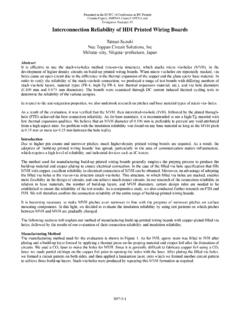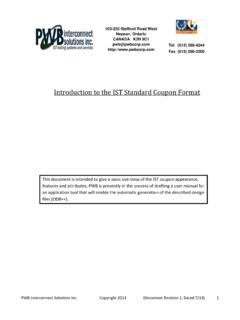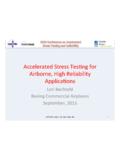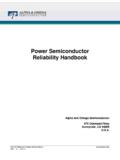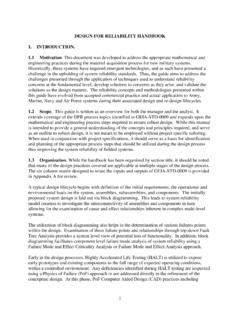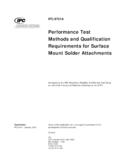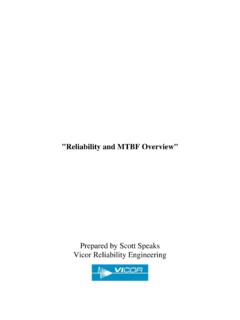Transcription of PRINTED WIRING BOARD RELIABILITY …
1 Copyright 2003 by Northrop Grumman Space Technology. Published by Society for the Advancement of Material and Process Engineering with Permission. PRINTED WIRING BOARD RELIABILITY EVALUATION METHODS CORRELATIONS OF IST VS THERMAL SHOCK Wennei Chen, Bill Bjorndahl, Brian Parrish Northrop Grumman Space Technology One Space Park, R6/2184, Redondo Beach, California 90278 Bill Birch PWB Interconnect Solutions, Inc 103-235 Stafford Rd. West, Ottawa, ON K2H 9C1, Canada Ronald Carter Alion/PMTEC 215 Wynn Drive, Suite 101, Huntsville, AL 35805 ABSTRACT Thermal tests and cross-section methods have been utilized as PRINTED WIRING BOARD (PWB) screening/qualification methods over the past several decades.
2 These traditional methods are expensive and take time to perform. The current market trend of reducing product-development-cycle time generates the need for highly accelerated test methods. A relatively new test method called Interconnect Stress Testing (IST) has demonstrated the capability of producing RELIABILITY data in a timely manner. In order to have confidence in the highly accelerated IST methods, the equivalence to more traditional methods must be established. This evaluation examined IST and IPC coupons associated with several PWB designs and PWB fabrication lots.
3 The coupons tested varied from an as-received condition to exposure of solder assembly cycles prior to IST and thermal shock testing. Cross-sectional microscopy techniques were applied on both coupon groups. This study found a correlation between IST and thermal shock test severity. The results indicated that a total of 300 IST cycles would induce fatigue effects on plated barrels at least as severe as 100 thermal shock cycles. KEY WORDS: Interconnect Stress Test (IST), Plated-Through Hole (PTH), Thermal Shock Equivalency 1.
4 INTRODUCTION The PRINTED WIRING BOARD (PWB) industry is continually developing new process technologies and utilizing new materials as they become available. Determining the feasibility of new PWB designs that utilize new materials and processes for high RELIABILITY space application is often a long and arduous process. The most common PWB screening/qualification method has been the use of thermal-oven tests in conjunction with cross-sections. This traditional method can no longer keep pace with PWB technology advancements. IST technology was developed in anattempt to generate RELIABILITY data in a timely manner.
5 This report presents the results of a correlation study among data produced by two (2) methods. The first group of data was generated by a well-known and widely-used traditional thermal-oven method called the thermal shock test , or shock test . It is similar to IPC-TM-650, Method , air-to-air cycling between -65 C ~ 125 C. This test involved a dwell time of 15 minutes at each temperature extreme and a maximum transition time of 2 minutes between the two extremes. No daisy chains were monitored since most of the coupons were the conventional IPC coupon types A and B.
6 Cross-sectioning microscopy analysis was conducted at the end of 100 cycles of thermal shock. The second group of data was generated by the relatively new IST method. The test was performed in accordance with IPC-TM-650, Method Unlike the first method above, no thermal oven was involved. All coupons were daisy chained. Each coupon consists of hundreds of plated barrels connected to form daisy chains. DC current was applied to one circuit, called the Power Circuit , to create heat through the BOARD substrate. The coupons were heated in this manner from ambient to 150 C in approximately 3 minutes.
7 A full IST cycle lasts approximately 6 minutes (including 3 minutes cool down). During each cycle, resistance changes for all circuit nets were continuously monitored. Coupon performance was tracked by small changes in resistance which indicated interconnect integrity changes. These changes indicated that failures were being initiated and the interconnect lost some ability to withstand further stress. As the test progresses, these small interconnect integrity changes increase the total circuit resistance due to the accumulated damage.
8 The IST machine graphed the resistance changes as a function of the numbers of IST cycles for each net. When larger changes are detected, the system automatically stops the testing at a pre-determined level. In order to understand how the IST method correlates to the thermal shock method, the data from the two test methods were compared. Cross-section microscopy analysis was performed on IST coupons after testing to compare with cross-sections from thermal shock tests. The goal was to establish a test-severity equivalency between IST and the thermal shock method.
9 Note that theoretical analyses were not within the scope of this investigation. The equivalency was derived based on empirical data and limited to certain PWB attributes. 2. COUPON DESCRIPTION A coupon test matrix is presented in Table 1. Both IST and IPC coupons were taken from each BOARD . The following attributes were considered to be important factors: Laminate total thickness / layer counts / internal lands Plated vias/holes/aspect ratios Polyimide base materials (Tg of 200 C minimum) Assembly-simulation conditions Copper plating thickness of minimum Although there were different PWB manufacturers and different base materials involved as denoted by fabrication lot in Table 1, the mix variables can be isolated by comparing data within their relevant lots, respectively.
10 3. INVESTIGATION APPROACH The investigation was performed as described in the following subsections. Incoming Electrical and Visual Evaluation All coupons were visually examined to confirm design intent. For IST coupons, resistance of each test circuit was measured at ambient condition. The values represent the initial state of the interconnect resistance and were used to evaluate acceptability for IST testing. Assembly Process Simulations The IST and IPC coupons were exposed to environments that were representative of typical assembly and rework processes.

